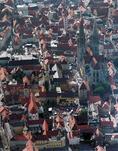Community conservation & preservation urban design periodic news regulation events adi revelation settlements history land use social practices large scale plans & projects immigration tourism premi tesi di dottorato resilience urban renewal fragile territories neighborhood conferences city-regions digitalization scali ferroviari economics
Street Life: Regensburg (Germany)
Design of Streets and Squares
The Project, the Stage and its Artists
The sophisticated network of streets, squares and alleys of Regensburg forms a basis for liv-ing environment of its residents. It is certainly interesting living in the 2000 years old-city, and it is a special challenge for the city planners to restore the streets of the city. Since 1984 nu-merous streets, squares and alleys have been newly designed step by step. By doing so, open spaces were provided to support urban activities and as a result, the identification of the residents with their city became stronger.
The City
Regensburg is the fourth largest city in Bavaria (city area: 8074 hectares, 143,000 residents). It is a diocesan town, seat of the government of the "Oberpfalz" and several national depart-ments and offices. Regensburg is situated at the most northern point of the river Danube where the Naab and Regen rivers come together. The city is the economic centre of the re-gion with a population of 300,000. Compared to other Bavarian cities the economic develop-ment is thriving. There is a good mixture of small, medium-sized and large companies. Re-gensburg is an important area for future technologies as well. In Regensburg, tradition and modern life are found together in a melting pot.
The old town of Regensburg is an ensemble of historic monuments occupying an important position in Europe. The structure of the early middle-ages development with its narrow alleys has been well preserved. The Patrician castles with their Italian-like ancient towers are unique north of the Alps. It is clearly visible, that the legion camp of the Romans "Castra Re-gina" represents the basis of the city. The old town of Regensburg contains several wonder-ful monuments of sacral and profane architecture and also a variety of simple tradesmens', fishermens' and town houses. Thanks to this heterogeneous structure of the architecture, we encounter a harmonious medieval townscape today.
The geographical and historic centre of Regensburg is the old part of the town with 14,000 residents providing 20,000 jobs on an area of 120 hectares. Retail trade can mainly be found there, occupying an area of 90,000 m², and there is a great deal of service industry as well. The old town is a large cultural centre for the region with its theatres, museums and numer-ous festivals and events. The status as a cultural city and the function as a magnet for tour-ism underline the importance of town planning for the old town in the city landscape.
Street Life
Because of the continuous restoration of the old town since 1955, the foundation of the uni-versity in 1963, the increase in population and an exceptionally large number of enterprises opening up (e.g. BMW, Siemens, AEG, Toshiba etc.), the city experienced an expansion and received a strong economic and cultural impulse as well. The fact that there are more than 20,000 students, a large number compared to the total number of inhabitants, is an important factor. Today, the old town has much to offer: people have opportunities to socialize, to go for walks, and to enjoy street cafes´, cultural events and festivals. Since the old town has been refurbished and there is no through traffic anymore, it is very pleasant to spend time there. Through new possibilities of enjoying the old town, the residents do not regard the heart of Regensburg as a fossil anymore, but are aware of the fact that their city is very at-tractive. The old town is not a facade for tourists; people live and work there. It is a special aim to connect the old town with the river Danube and the adjoining neighbourhoods. Some parts of the river bank have already been integrated with each other by several projects.
The conscious preservation of historic monuments and buildings, together with the atmos-phere of a 2000-years-old city, reveals the beauty and importance of the old town which will be further developed into a lively centre of the city.
Design of Streets and Squares
In the 1960's and 1970's the renovation of the old town meant the restoration of buildings in-cluding the improvement of the residential area. It was only in the 1980's that the importance of the development of public places in the old town was taken into consideration in a more general view.
There was a competition in 1982 for the restructuring of streets and squares in the old town. Accordingly, new models for town planning were developed:
• using cobbles in rows which vary in width, having irregular gaps
• structuring of broad streets and squares simply by a change in size and direction of the cobbles
• using large cobbles from wall to wall as connecting pathways . Artists designed, for ex-ample, fountains and the bollards at the "Kohlenmarkt"
• gutters built in an unobtrusive way in muted colours, using large cobbles
• strict standards for the choice and design of the furniture
In the 1980's initial steps were taken for traffic calming before thought was given to a new design for streets and squares in the old town. Even then, one was able to see possibilities for the old town without through traffic and large parking areas.
Thus, most streets in the old town, mainly residential, but also shopping areas, were changed to footpaths and cycleways. This area is only accessible for traffic at walking speed if , e.g., residents parking their cars or for the delivery of goods. Town planners continued with the traffic calming in 1991 and extended the areas concerned. With the completion of the southern by-pass of the old town at the end of 1994, it was possible to extend the traffic calming to parts of the city which were still burdened with traffic problems.
Public Areas Demand Continuous Town Planning
Based on the result of competition, numerous newly-designed streets and squares can be found. Moreover there are many small impressive projects such as the so-called "sequence of squares", for example, the bank of the river Danube alongside the "Thundorferstraße" as well as the newly designed "Neupfarrplatz" and the "Gesandtenstraße". In the year 2002 the "St. Kassians-Platz" and the main street at "Stadtamhof" will be restructured.
The townscape is very much influenced by high quality and individual design of the streets and squares. The projects in the historic old town are excellent examples for other parts of the city. The aim is to transfer the present standard of the old town, which is very high, to the surrounding areas. This has already been accomplished with the new look of the "Kumpfmühler Market Square"
Over and above that the city seized the opportunity to develop a high standard of town plan-ning through further competitions. In the future, competitions will still be the basis of the de-velopment of essential projects.
Since 1998 an independent committee has been providing expert advice on the outstanding projects of the city concerning architecture and town planning. The committee has a very positive influence on the building contractors and architects and especially on the style of planning.
To fit the requirements of public areas, town planning has to be flexible. There are new frame conditions through the competition between shopping malls, shopping streets and new mar-kets on the internet. Today, there are numerous events in public spaces, and advertising as well as the introduction of various shops play an important role. Therefore, certain laws were introduced to provide guidelines for advertisements, market stalls, and the presentation of goods.
Resumè
The revival of the heart of the city is the main objective of the redesign of streets and squares. It is important to have a detailed plan and framework which supports a flexible de-velopment considering the process and special conditions. It is to be hoped that in the future the existing network of amenities can be developed continuously since these programmes are vital for the cultural future of the city and the surrounding region.
Related articles:
- Street Life: Cosenza (Italy)
- Street Life: Dublin (Irland)
- Street Life: Graz (Austria)
- Street Life: Groningen (The Netherlands)
- Street Life: Leeds (United Kingdom)
- Street Life: Munich (Germany)
- Street Life: Nijmegen (The Netherlands)
- Street Life: Porto (Portugal)
- Street Life: Salerno (Italy)
- Street Life: Strasbourg (France)
- Street Life: Turin (Italy)
- Street Life: Vienna (Austria)




Planum
The Journal of Urbanism
ISSN 1723-0993
owned by
Istituto Nazionale di Urbanistica
published by
Planum Association
ISSN 1723-0993 | Registered at Court of Rome 4/12/2001, num. 514/2001
Web site realized by ChannelWeb & Planum Association | Powered by BEdita 3






